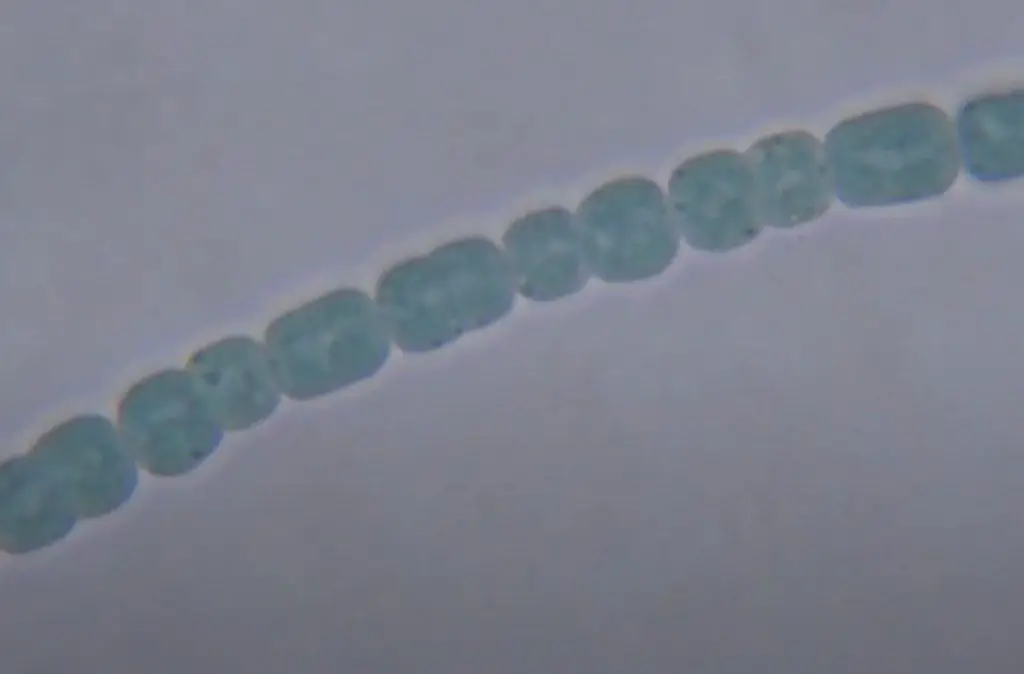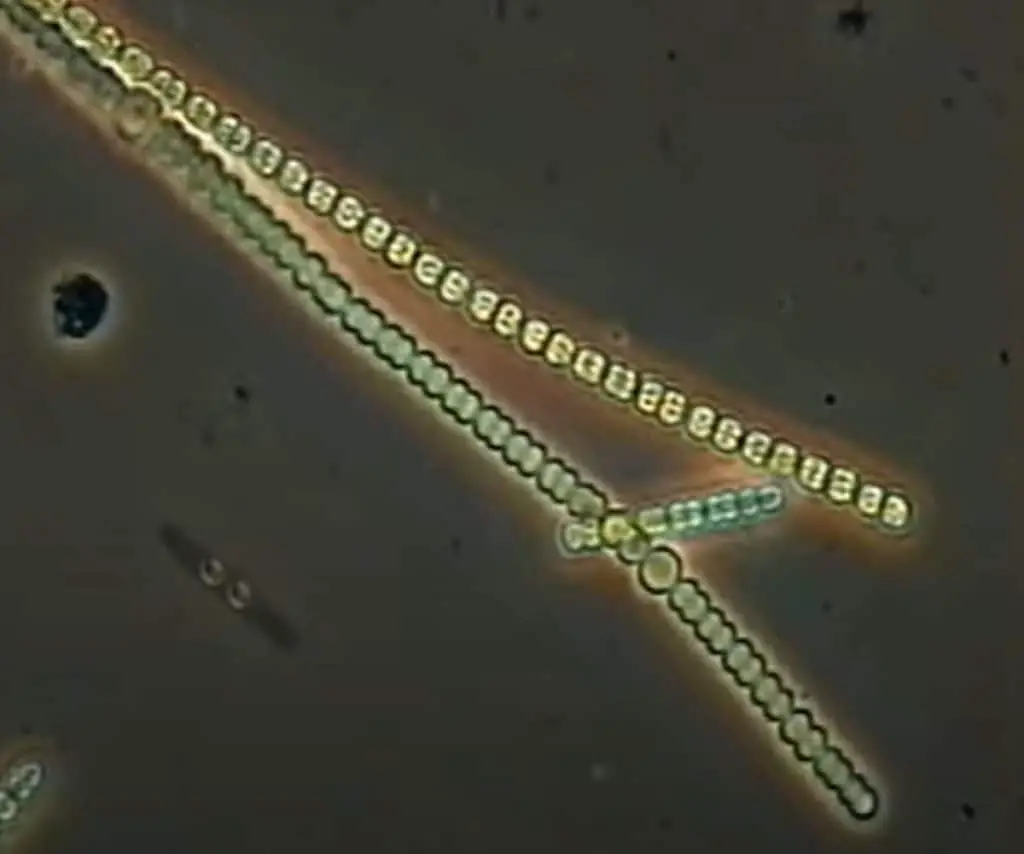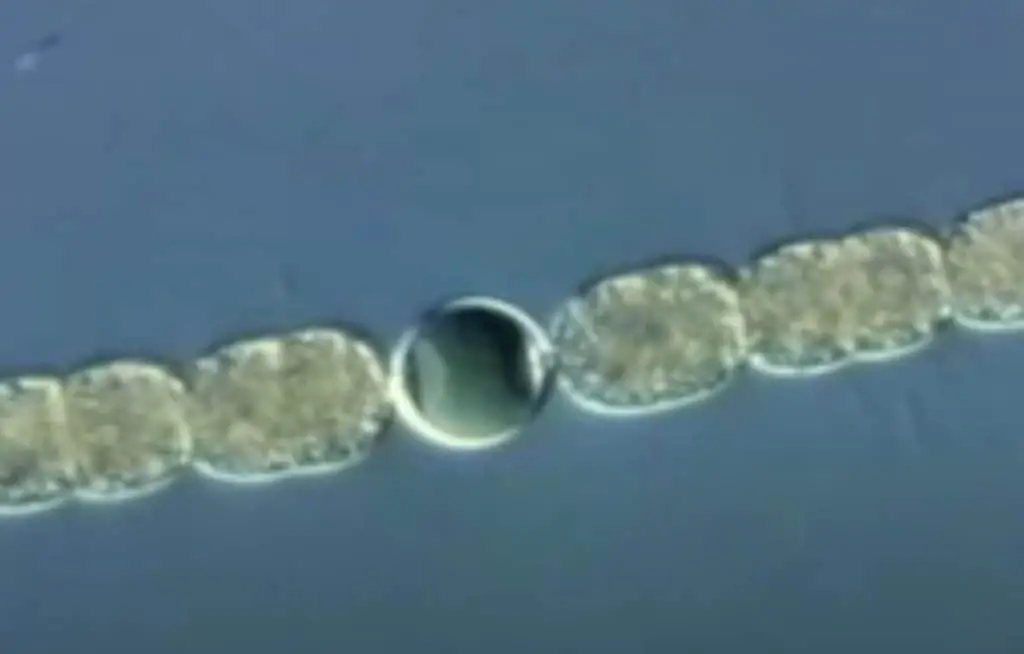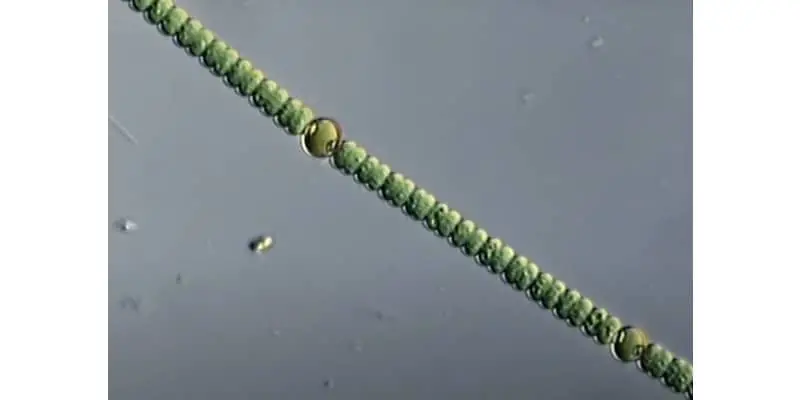Anabaena is a genus of nitrogen-fixing cyanobacteria that exist as plankton. The blue-green algae are symbiotic in nature but produce neurotoxins, which are detrimental to plants, wildlife, and even humans. Anabaena are shaped like a string of beads and found mostly in shallow water or in wet soil.
In this post you will gain a deeper understanding of anabaena which will bolster your observation of these microorganisms under the microscope. Anabaena are often overlooked when looking at other more lively microorganisms under the microscope but despite their appearance there is much more than meets the eye.
How Are Anabaena Classified?

All life on earth can be grouped based on a rated system of similar species based on structure and genetics. The Domain sits atop this ranking system as the broadest grouping, followed by Kingdom, Phylum, Class, Order, Family, Genus, and Species. Let’s take a closer look at how Anabaena are classified:
- Domain: Bacteria – Bacteria are prokaryotic. They lack a nucleus, organelles, and have membranes that possess diacyl glycerol diester lipids. Cyanobacteria like Anabaena make up a large portion of life within this Domain. The Domain is incredibly diverse, so diverse that it is nearly impossible to estimate how many species of bacteria actually live amongst us. This is thanks to their horizontal gene transfer abilities.
- Phylum: Cyanobacteria – Also known as Cyanophyta, this Phylum comes from the blue-green color. The Phylum is known as blue-green algae but is in fact not algae at all. Algae are strictly prokaryotic. This type of algae is unique in that they appear to have originated in freshwater and terrestrial habitats. Cyanobacteria like Anabaena uniquely have internal membranes that are flattened sacs called thylakoids. This is where photosynthesis takes place. Cyanobacteria produce a wide range of neurotoxins known as cyanotoxins, which can be dangerous to plants and animals, including humans.
- Class: Cyanophyceae – This class is made up of 150 genera and over 2,500 species. Defining characteristics include a nucleus that is prokaryotic by nature, meaning that it is devoid of a nuclear membrane. They do not have well-organized organelles. Their pigments are scattered throughout their chromoplast. Pigments are mostly blue-green thanks to c-phycocyanin. Other pigments like green, thanks to chlorophyll, and red, thanks to B-carotene exist.
- Order: Nostocales – A grouping of filamentous cyanobacteria that may be simple or branched. Anabaena are simple. Some members, like the Anabaena, have heterocysts. Unfortunately, the order is mostly disregarded amongst the scientific community and not well-studied. Nostocales live in temperate environments with poor lighting and a high phytoplankton biomass, meaning that they are found mostly in shallow freshwater environments. Recent studies show that Nostacles thrive in phosphorous-rich environments.
- Family: Nostocaceae – A family of cyanobacteria that form filament-shaped colonies which are surrounded by mucus or gelatinous sheath. Most are primarily found in freshwater, including the Anabaena. The family is known for forming symbiotic relationships with plants such as the mosquito fern, cycads, and hornworts. They provide nitrogen for their host.
- Genus: Anabaenas – The Anabaena provide nitrogen which grows during the growing season and is then plowed into the soil for the harvest, which has been shown to be an effective fertilizer.
Common Types of Anabaena

There are over 339 known species of Anabaena. Unfortunately, Anabaena are not widely studied so there is not a lot of information available about the different species. Below is a list of the most common species of Anabaena:
- Anabaenas aequalis: Freshwater species found in California, Argentina, and a part of Europe.
- Anabaenas affinis: Mostly freshwater species found in California and Northern Europe and parts of Spain. Species has been observed in the Atlantic Ocean as well.
- Anabaenas azollae: Forms mainly a symbiotic relationship with the fern Azolla. The symbiotic relationship and expedited rate that the A. azollae provides the fern with nitrogen has resulted in the fern being categorized as a ‘super plant’. With the help of the Anabaena, the fern can double its biomass in as little as 1.9 days. The limiting factor of growth tends to be phosphorus. Phosphorus runoff from agriculture has been known to cause huge blooms of A. azollae. The species is completely dependent upon the fern for life.
- Anabaenas circinalis: A Gram-negative species that is widely studied thanks to its ability to secrete harmful cyanotoxins that range from irritating to lethal. This species is known to grow in large, algae-like blooms that is detrimental to other inhabitants of the same environment. The species is found mainly in freshwater environments and is widely distributed throughout the world. They produce anatoxin-a, which was the first cyanobacterial neurotoxin discovered in the 1950s. The research stemmed from the death of cattle which was attributed to drinking water contaminated with this species. Anabaena circinalis are known to produce paralytic shellfish toxins (PSTs) which can be lethal and have been weaponized by militaries throughout the world. One PST consists of saxitoxin is considered the ‘suicide pill’ for military members to consume before being captured by their enemy. Saxitoxins have the ability to be used as a biological weapon and have no practical use aside from manufacturing weapons.
- Anabaenas flos-aquae flos-aquae: Varies from 4 to 50 micrometers in length. This species grows in clumps of multi-cell chains. They are longer than most other species of Anabaena and have a glass-like appearance. They can be both benthic or planktonic and can be found in North America, Sweden, Denmark, France, and Germany.
- Anabaenas variabilis: A species that has the ability to be heterotrophic, meaning that it can grow without sunlight and with just sugars. The species is used as a model organism to study the beginnings of multicellular life thanks to its unique filamentous structure and cellular differentiation abilities.
Other Notable Species:
- Anabaenas angstumalis angstumalis
- Anabaenas angstumalis marchita
- Anabaenas aphanizomendoides
- Anabaenas bornetiana
- Anabaenas catenula
- Anabaenas cedrorum
- Anabaenas confervoides
- Anabaenas constricta
- Anabaenas cyanobacterium
- Anabaenas cycadeae
- Anabaenas cylindrica
- Anabaenas echinispora
- Anabaenas felisii
- Anabaenas helicoidea
- Anabaenas inaequalis
- Anabaenas lapponica
- Anabaenas laxa
- Anabaenas lemmermannii
- Anabaenas levanderi
- Anabaenas limnetica
- Anabaenas macrospora macrospora
- Anabaenas macrospora robusta
- Anabaenas monticulosa
- Anabaenas nostoc
- Anabaenas oscillarioides
- Anabaenas planctonica
- Anabaenas raciborskii
- Anabaenas scheremetievi
- Anabaenas sphaerica
- Anabaenas spiroides crassa
- Anabaenas spiroides spiroides
- Anabaenas subcylindrica
- Anabaenas torulosa
- Anabaenas unispora
- Anabaenas verrucosa
- Anabaenas viguieri
- Anabaenas wisconsinense
- Anabaenas zierlingii
Nitrogen Fixation of Anabaena

Nitrogen fixation is a chemical process where molecular nitrogen within the atmosphere is converted into ammonia. In the atmosphere, nitrogen is dinitrogen which is mostly nonreactive and relatively unusable to a vast majority of life on earth. Nitrogen fixation is considered an essential process to all living creatures because the fixed inorganic nitrogen compounds aid in the biosynthesis of amino acids, proteins, and nucleic acids.
The nitrogen cycle is the process in which nitrogen is converted into many different forms as it passes through the atmosphere, living creatures, and oceans. Nitrogen fixation is an essential process within the nitrogen cycle. Understanding nitrogen fixation and the nitrogen cycle is crucial in agriculture and their use of nitrogen in fertilizers.
The fixation of nitrogen was first discovered by Jean-Baptiste Boussingault in the year 1838. Boussingault was a French chemist who is praised for his contributions to agricultural science, the petroleum industry, and metallurgy. He discovered that an increase in nitrogen in the soil resulted in more productive growth of legume crops.
The nitrogen fixation process was further described by Hermann Hellriegel in the year 1880. Hellriegel was a German chemist who also focused on legume plants. His experiments focused mainly on demonstrating that legumes had the ability to assimilate nitrogen from thin air. He was able to describe the tubercles of the roots where nitrogen fixation takes place in legumes.
Nitrogen fixation was finally fully described by Martinus Beijerinck in 1901 when he demonstrated that azotobacter chroococcum was able to fix atmospheric nitrogen. Beijerinck was a microbiologist and botanist from the Netherlands that is credited as a father of virology and even environmental microbiology.
Beijerinck’s claim to fame is the discovery of viruses, but also discovered and described the biological and chemical processes that occurred within the root nodules of legumes as it relates to soil fertility and agriculture. He was the first to describe the overall reaction equation of biological nitrogen fixation.
As previously stated, nitrogen is typically inaccessible to the great majority of organisms on earth. This is thanks to its incredibly strong triple covalent bond. Anabaenas are amongst the few organisms alive that are tough enough to fixate the nitrogen and distribute it in different forms throughout the nitrogen cycle.
Cyanobacteria like the Anabaena can be found in virtually every environment on earth that receives sunlight. Anabaena can use various forms of nitrogen, including nitrates, nitrites, ammonium, urea, and even amino acids. Nitrogen fixation by cyanobacteria in the oceans can fix up to twice as much nitrogen as on land. Anabaena are special amongst cyanobacteria in that they have heterocysts, which are specialized nitrogen-fixating cells using the enzyme nitrogenase. Nitrogenase becomes inactive in the presence of oxygen, which means that the Anabaena must be in an anaerobic environment.
Are Anabaena Dangerous to Humans?
Certain species of anabaena are potentially harmful to plants, wildlife, and even humans. Anabaena are only one of four genera that produce harmful cyanotoxins. Large blooms of Anabaenas, usually caused by excess phosphorous in the environment, and can lead to the secretion of a large enough amount of cyanotoxins that starts to harm its surrounding environment.
Cyanotoxins can make an individual who was exposed to it sick. Symptoms are wide-ranging and depend on how a person was exposed, how long they were exposed, and what type of toxin they were exposed to. Exposure can be a result of skin contact with water that contains toxins. This can happen while swimming or engaging in other activities such as fishing within the water.
Other exposures can be triggered by drinking contaminated water. It’s possible to become exposed through breathing mists or tiny droplets that contain cyanotoxins. Eating fish or shellfish that contain cyanotoxins may pass it on to humans. Lastly, some nutritional supplements have been reported to be contaminated with cyanotoxins.
Symptoms are usually mild and may include irritation of the eyes, nose, throat, and lungs. These symptoms are typically a result of exposure through touch or inhalation. Exposure through eating or swallowing cyanotoxins may trigger symptoms such as stomach pain, headache, muscle weakness, dizziness, vomiting, diarrhea, and even liver damage.
If you think that you’ve been exposed to a harmful cyanotoxin, then talk to your healthcare provider immediately. If symptoms are more severe, then you should call the poison control center. Make sure to report any illness to your local or state health department. The local health department will work in conjunction with other government agencies to alert the public of the contaminated source and also remediate it.
The long-term side effects of cyanotoxins remain unclear as there is little research. Some theorize that cyanotoxin exposure may lead to Beta-N-methylamino-L-alanine, or BMAA, which causes neurological diseases like amyotrophic lateral sclerosis (ALS). More research is needed to strengthen the connection between BMAAs and cyanotoxins.
Anabaena are amongst the most toxic cyanobacteria. Some of the most common cyanotoxins include microcystin, cylindrospermopsin, anatoxin, saxitoxin, nodularin, and lyngbyatoxins. There are over 50 different types of discovered microcystin. The toxin is produced in large quantities during algal blooms that are a major threat to drinking water supplies and irrigation supplies. Exposure includes mainly gastrointestinal issues.
The largest outbreak of microcystin on record occurred in Lake Eerie in 2011, which created massive dead zones, reduced fish populations, ruined public beaches, and damaged local tourism economically. It’s estimated that this outbreak alone caused more than $10 billion in damage. Other impacted areas include the San Francisco Bay and drinking water supplies in Iowa.
Cylindrospermopsin was discovered in 1979 when over 130 residents of an Australian island were admitted to the hospital. Each patient suffered from gastroenteritis. Symptoms included abdominal pain and vomiting. More severe symptoms included kidney failure and bloody diarrhea. The outbreak was linked to a severe algal bloom that impacted the water supply.
Anatoxin is one of the most deadly and severe cyanotoxins produced by Anabaenas. It’s known as the Very Fast Death Factor (VFDF). Symptoms include a loss of coordination, muscular fasciculations, convulsions, and even death by respiratory paralysis. Although mostly found in freshwater environments, anatoxins may be produced by Anabaena in other saline environments. One study found anatoxin-a in 38% of aquatic plants sampled in Nebraska. This toxin is extremely common and widely distributed across the globe. Thankfully, it’s easily detected and treated.
Saxitoxin is the deadliest cyanotoxins produced by Anabaenas. It’s otherwise known as ‘Paralytic Shellfish Toxin (PST) and causes Paralytic Shellfish Poisoning, or PSP. It’s particularly prevalent in bivalves such as mussels, clams, and oysters. Outbreaks have led to the banning of commercial and recreational shellfish harvesting in temperate coastal waters where saxitoxin is present.
Most alarmingly, militaries across the world have been interested in saxitoxin for its use as a biological weapon. This is thanks to its extremely low LD50. It was developed as a chemical weapon first by the United States military and is used covertly by the CIA. The CIA is known to have used a small does to capture a U-2 spy plane pilot. Saxitoxin was also used as a ‘suicide pill’. Instead of being captured by the enemy, a soldier was to consume a pill containing saxitoxin to kill themselves before being tortured by the enemy and giving away top-secret information.
Nodularin is unique in that it is found mainly in brackish water algal blooms. This cyanotoxin is a result of some of the largest algal blooms in the world. There are 10 variants known to date. It leads to gastroenteritis, allergic irritation reactions, and liver diseases. It gained notoriety as a potent hepatotoxin. Lyngbyatoxins are produced by certain species of Anabaena as a defense mechanism to ward off any predators. It’s a potent blistering chemical and also a carcinogen. Exposure to this toxin causes a common skin condition known as seaweed dermatitis.
Are Anabaena Dangerous to Animals?
Just like humans, Anabaena can be harmful to animals as well. Dogs are at an elevated risk of poisoning due to their behaviors. Behaviors that may lead to exposure include swimming, drinking contaminated water, eating dead fish or amphibians, and licking algal scum from their fur after a swim. Dogs may similarly be poisoned by eating supplements that are contaminated with cyanotoxins.
Cattle and other farm animals are at an increased risk of exposure. Algal blooms are often a result of excess phosphorous. The Anabaenas help fix nitrogen for plants that they are symbiotic with. The excess phosphorous allows for blooms to grow out of control. Excess phosphorous and other fertilizers are more prevalent at farms from agricultural runoff of fertilizer. Ponds that livestock drink from may be suffering from an algal bloom that gives off harmful cyanotoxins.
Although Anabaena are mainly freshwater microorganisms, marine mammals are also at risk. In 2007, over 20 sea otters were killed in the Monterey Bay from a river that flowed with a large Anabaena—caused bloom. Cyanotoxins may carry downstream and impact the mouths of estuaries in marine environments as well. Cyanotoxins may cause avian botulism in exposed birds. Avian botulism is a disease that causes paralysis in birds. Lastly, fish and other aquatic animals are largely unaffected by the toxins but are directly impacted by the algal blooms themselves. Algal blooms use up the oxygen in the water which causes fish and aquatic vegetation to suffocate.
History of Anabaena
The history of Anabaena and other cyanobacteria dates to the origins of life on Earth. The latest fossil records of cyanobacteria dated back to rocks over 3,500 years of age in Western Australia. Cyanobacteria are best known to the world as blue-green algae. Without organelles and distinct nuclei, they are more of a bacterium than an alga.
Prokaryotes are thought to be the oldest forms of life on Earth. Prokaryotes fed on carbon that was built up within the Earth’s oceans. Over time, organisms evolved to utilize the Sun’s energy to help them produce their own energy. Cyanobacteria like the Anabaena took it a step further by using water to aid in a process called photosynthesis.
Photosynthesis is the process of converting sunlight and carbon dioxide into usable sugars and oxygen as a byproduct. Thanks to this photosynthetic process, cyanobacteria like Anabaena are credited with producing oxygen in the Earth’s atmosphere that now allows for oxygen-metabolizing organisms like humans to exist.
Cyanobacteria gave us more than just the oxygen that we depend on to survive but are also credited with forming a symbiotic relationship with prokaryotes that resulted in the formation of eukaryotic cells. It’s theorized that a bacterium like cyanobacteria was engulfed by another and that the smaller of the two persisted within. The relationship was beneficial to both organisms and over time they evolved into the complex eukaryotic cells that we are familiar with today.
References
- https://www.nature.com/articles/ismej201225
- https://www.ncbi.nlm.nih.gov/pmc/articles/PMC3705384/
- http://oceandatacenter.ucsc.edu/PhytoGallery/Freshwater/Dolichospermum%20flos-aquae.html
- https://www.mass.gov/info-details/microcystis-and-anabaena-algae-blooms
- https://genome.jgi.doe.gov/portal/anava/anava.home.html
- https://www.biologydiscussion.com/algae/cyanophyceae-characteristics-occurrence-and-classification/46739
- https://www.cdc.gov/habs/illness-symptoms-freshwater.html


